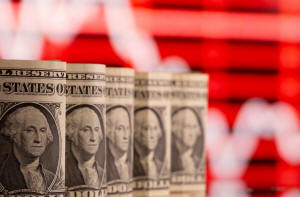U.S. investors brace for more wild market gyrations after dizzying Q3
 Send a link to a friend
Send a link to a friend
 [September 30, 2022] By
Saqib Iqbal Ahmed and Lewis Krauskopf [September 30, 2022] By
Saqib Iqbal Ahmed and Lewis Krauskopf
NEW YORK (Reuters) - In a year of wild
market swings, the third quarter of 2022 was a time when events took a
truly extraordinary turn.
As the Federal Reserve ratcheted up its monetary policy tightening to
tame the worst inflation in decades, U.S. Treasury yields shot to their
highest levels in more than a decade and stocks reversed a summer rally
to plumb fresh depths.
The S&P 500 is down nearly 24% year-to-date, while yields on the
benchmark 10 year Treasury note, which move inversely to bond prices,
recently hit their highest level since 2008.
Outside the United States, the soaring dollar spurred big declines in
global currencies, pushing Japan to support the yen for the first time
in years. A slump in British government bond prices, meanwhile, forced
the Bank of England to carry out temporary purchases of long-dated
gilts. Many investors are looking to the next three months with
trepidation, betting the selloff in U.S. stocks will continue until
there are signs the Fed is winning its battle against inflation. Yet the
last quarter of the year has often been a beneficial time for U.S.
equities, spurring hopes that markets may have already seen the worst of
the selloff.

PASS THE DIP
The strategy of buying stock market dips yielded rich rewards for
investors in the past but failed badly in 2022: the S&P 500 has rallied
by 6% or more four times this year and went on to make a fresh low in
each instance.
The third quarter saw the index rise by nearly 14% before reversing to
make a fresh two-year low in September after investors recalibrated
their expectations for even more aggressive Fed tightening.
LOOK OUT BELOW?
With several big Wall Street banks expecting the benchmark index to end
the year below current levels - Bank of America and Goldman Sachs both
recently published year-end targets of 3,600 - the outlook for
dip-buying remains murky.
In addition, the current bear market, which has so far lasted 268 days
and notched a peak-to-trough decline of about 24%, is still relatively
short and shallow compared with past drops. Since 1950, the average bear
market has lasted 391 days with an average peak-to-trough drop of 35.6%,
according to Yardeni Research.
LOOK TO BONDS
Though equities have been volatile, the gyrations in bond markets have
been comparatively worse.
The ICE BofAML U.S. Bond Market Option Volatility Estimate Index shot to
its highest level since March 2020 as the ICE BofA US Treasury index is
on track for its biggest annual drop on record.

[to top of second column] |

U.S. one dollar banknotes are seen
in front of displayed stock graph in this illustration taken
February 8, 2021. REUTERS/Dado Ruvic/Illustration/File Photo

By comparison, the Cboe Volatility Index - the so-called Wall Street
"fear gauge" - has failed to scale its March peak.
Some investors believe stock turbulence will continue until bond
markets calm down.
"I think there is a good scenario where once we get through the bond
market violence, we get to a more tradable bottom (for stocks),"
said Michael Purves, chief executive at Tallbacken Capital Advisors
in New York.
…AND THE DOLLAR
Soaring U.S. interest rates, a relatively robust American economy
and investors' reach for safe haven amidst a rise in financial
market volatility has boosted the U.S. dollar – to the detriment of
other global currencies.
The greenback is up about 7% for the quarter against a basket of
currencies and stands near its highest level since May 2002. The
dollar’s strength has the Bank of Japan to shore up the yen through
interventions while also presenting an earnings headwind for U.S.
corporates.
"Market risk-takers are grappling with the double-barreled threat of
persistent dollar strength and dramatically higher interest rates,"
Jack Ablin, chief investment officer at Cresset Capital, said in a
note.
EARNINGS TEST
Third quarter earnings may present another obstacle to markets, as
companies factor in everything from dollar-fueled currency headwinds
to supply chain issues.
Analysts have become more downbeat on third quarter profit growth,
with consensus estimates falling to 4.6% from 7.2% in early August,
according to Refinitiv IBES. So far, that is only slightly worse
than the median 2.2 percentage point decline ahead of reporting
periods historically, yet warnings from companies such as FedEX and
Ford have hinted at the possibility of more pain to come.

'TIS THE SEASON
The calendar may offer weary stock investors some hope.
The fourth quarter is historically the best period for returns for
major U.S. stock indexes, with the S&P 500 averaging a 4.2% gain
since 1949, according to the Stock Trader's Almanac.
(Reporting by Saqib Iqbal Ahmed and Lewis Krauskopf; Editing by Ira
Iosebashvili and Marguerita Choy)
[© 2022 Thomson Reuters. All rights
reserved.]
This material may not be published,
broadcast, rewritten or redistributed.
Thompson Reuters is solely responsible for this content. |